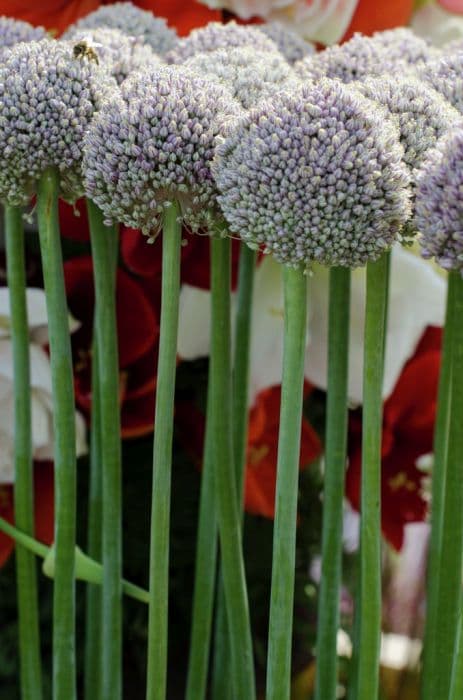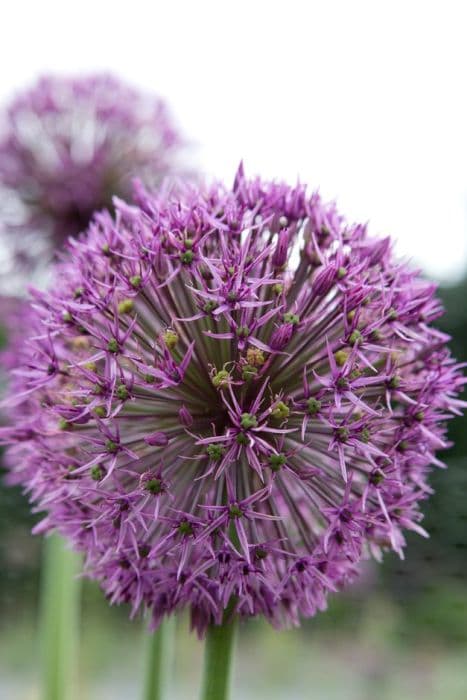Society garlic Tulbaghia violacea











ABOUT
Commonly known as society garlic, this plant features long, narrow, and strap-like green leaves that have a strong garlic-like scent when crushed. The leaves grow in a clump formation, emerging from a central point and arching gracefully outwards. One of the most striking aspects of society garlic is its blooms. The flowers develop in clusters at the top of tall, slender stems that rise above the foliage. The individual flowers are typically violet or lilac in color, with a tubular shape that flares into six-pointed stars at the ends. These star-shaped blossoms are grouped into umbel-like clusters and can provide a vibrant display. The flowers often attract various pollinators, adding to the plant's charm. The overall appearance of society garlic is lush and ornamental, with both foliage and flowers contributing to its aesthetic appeal in gardens and landscapes.
About this plant
 Names
NamesFamily
Amaryllidaceae.
Synonyms
Society Garlic, Pink Agapanthus, Sweet Garlic, Wild Garlic, Kitchen Window Garlic, Tulbaghia.
Common names
Tulbaghia cepacea, Tulbaghia dregeana, Tulbaghia alliacea.
 Toxicity
ToxicityTo humans
The plant commonly known as society garlic (Tulbaghia violacea) is not considered highly toxic to humans. However, as with many plants, consuming large amounts of society garlic, especially raw, could potentially cause gastrointestinal upset, including symptoms like nausea, vomiting, or diarrhea. It is always a good practice to avoid eating large quantities of plants that are not typically recognized as food without proper knowledge or guidance.
To pets
Society garlic (Tulbaghia violacea) is also not highly toxic to pets, but it can cause similar mild gastrointestinal upset as in humans if ingested in large quantities. Signs of ingestion might include drooling, nausea, vomiting, or diarrhea. As pets may be more sensitive to plant compounds than humans, it's wise to prevent them from eating significant amounts of this or any ornamental plant. If you suspect your pet has ingested a potentially toxic plant, it is advisable to consult with a veterinarian.
 Characteristics
CharacteristicsLife cycle
Perennials
Foliage type
Evergreen
Color of leaves
Green
Flower color
Purple
Height
1-2 feet (30-60 cm)
Spread
1-2 feet (30-60 cm)
Plant type
Herb
Hardiness zones
7-10
Native area
South Africa
Benefits
 General Benefits
General Benefits- Low maintenance: Tulbaghia violacea, commonly known as society garlic, requires minimal care once established, making it an ideal plant for both novice and experienced gardeners.
- Drought-tolerant: Society garlic is well-adapted to arid conditions, conserving water and thriving with infrequent irrigation once fully established.
- Pest-resistant: The plant's strong odor is a natural deterrent to many pests, reducing the need for chemical pesticides.
- Edible parts: The leaves and flowers of society garlic are edible, with a flavor similar to mild garlic, and can be used in culinary dishes.
- Ornamental value: With its vibrant purple flowers and attractive foliage, society garlic adds aesthetic appeal to gardens, borders, and containers.
- Durability: Society garlic is a hardy plant that can tolerate a wide range of growing conditions, making it a reliable addition to diverse gardens.
- Ground cover: The spreading nature of society garlic makes it an excellent ground cover, helping to suppress weeds and reduce soil erosion.
 Medical Properties
Medical Properties- Antimicrobial: Tulbaghia violacea has been reported to have antimicrobial properties, effective against a variety of microorganisms.
- Anti-inflammatory: The plant contains compounds that have been identified to have anti-inflammatory effects.
- Antihypertensive: There is some evidence to suggest that it may have properties that help in lowering blood pressure.
- Antidiabetic: Some research indicates potential antidiabetic effects, through influencing blood sugar levels.
- Antitumor: Compounds within Tulbaghia violacea may exhibit antitumor activity, although this is based on preliminary research.
- Anthelmintic: The plant has been used traditionally to treat intestinal worms and other parasitic infections.
 Air-purifying Qualities
Air-purifying QualitiesThis plant is not specifically known for air purifying qualities.
 Other Uses
Other Uses- Tulbaghia violacea, commonly known as society garlic, is often planted as a companion plant in vegetable gardens to deter pests like aphids and snails with its strong garlic-like scent.
- The leaves of society garlic can be used as a flavoring in salads and other dishes, much like chives or garlic, adding a mild garlic taste to culinary creations.
- The plant's flowers can be edible and are sometimes used as a colorful garnish or decoration on food plates due to their striking purple color.
- Society garlic can be used in crafting and potpourri as the bulbs produce a fragrant oil that can impart a subtle garlic scent.
- The plant is commonly used to create a border or edging in gardens due to its clumping nature and attractive foliage and flowers.
- In ornamental water gardens, society garlic can be grown in boggy or waterside conditions, adding a structured and colorful element to the landscape.
- The sap from the plant is known to be adhesive and has been used traditionally to repair small cracks in glass.
- Due to its hardiness and ability to thrive in different soil conditions, society garlic is used in erosion control efforts in some landscapes.
- Gardeners can use the leaves as a natural marker or pointer when labeling different sections in herb gardens because of their distinctive aroma and shape.
- Society garlic is at times used in perfumery for creating unique scents, particularly for outdoor fragrance products designed to blend with natural garden smells.
Interesting Facts
 Feng Shui
Feng ShuiSociety garlic is not used in Feng Shui practice.
 Zodiac Sign Compitability
Zodiac Sign CompitabilitySociety garlic is not used in astrology practice.
 Plant Symbolism
Plant Symbolism- Spiritual Protection: Tulbaghia violacea, commonly known as "Society Garlic," is often associated with spiritual protection due to its strong aroma, which is believed to ward off evil spirits or negative energies.
- Healing and Medicinal Properties: The association with healing stems from the plant's traditional use in various cultures for its medicinal qualities, such as treating colds and flu, signifying its capacity to nurture and restore health.
- Sociability and Community: Society Garlic's common name itself suggests a connection with social spaces and gatherings, symbolizing the importance of community and cooperation.
- Endurance and Resilience: As a hardy and tolerant plant that can survive in difficult conditions, Society Garlic represents the human qualities of resilience and the ability to endure hardship.
- Purification: Its strong cleansing scent and antimicrobial properties relate to the idea of purification, both in a physical and in a metaphysical sense, suggesting the removal of impurities or negativity.
 Water
WaterSociety garlic requires moderate watering. During active growth in spring and summer, water when the top inch of soil feels dry, which is approximately every 7-10 days. Each watering session should provide enough water to moisten the soil throughout the pot, equating to around 16-24 ounces depending on pot size. During dormant periods in fall and winter, reduce watering to every two weeks, ensuring the soil doesn't remain soggy since overwatering can lead to root rot.
 Light
LightSociety garlic thrives in full sun to partial shade. It prefers a spot that receives at least six hours of direct sunlight daily but can also tolerate some afternoon shade, particularly in hotter climates. Ensuring a good amount of light will help the plant produce its characteristic purple flowers and maintain a robust growth.
 Temperature
TemperatureSociety garlic is comfortable in a temperature range of 50-90°F, with it ideally flourishing at around 70°F. It can withstand brief periods of colder temperatures down to about 20°F. To encourage flowering and vigorous growth, keep society garlic in a location that avoids extreme temperature fluctuations and protect it from frost.
 Pruning
PruningSociety garlic benefits from pruning to remove spent flower stalks and to encourage a bushier growth habit. This is best done after the plant has finished blooming, typically in late summer or fall. Prune away any dead or yellowing foliage as needed to maintain a tidy appearance and to promote healthy new growth.
 Cleaning
CleaningAs needed
 Soil
SoilSociety garlic prefers well-drained soil rich in organic matter. A soil mix consisting of two parts loam, one part sand or perlite, and one part compost or peat moss will support healthy growth. The optimal soil pH for society garlic should be slightly acidic to neutral, ranging from 6 to 7.
 Repotting
RepottingSociety garlic should be repotted every 2 to 3 years to ensure it has enough space to grow. It's important to choose a container with adequate drainage holes to prevent waterlogging.
 Humidity & Misting
Humidity & MistingSociety garlic thrives in moderate humidity levels. While it can tolerate some dryness, maintaining a humidity level around 40-50% is ideal for this plant.
 Suitable locations
Suitable locationsIndoor
Place society garlic in bright, indirect light indoors.
Outdoor
Grow in sun to partial shade with well-drained soil.
Hardiness zone
7-10 USDA
 Life cycle
Life cycleTulbaghia violacea, commonly known as society garlic, is a perennial plant that begins its life cycle as a bulb. The bulb germinates, producing linear, strap-like leaves, and establishes a root system. As the plant matures, it forms clumps by producing offsets from the parent bulb, entering a vegetative growth stage. The next phase is the flowering stage, when society garlic produces tall stems topped with clusters of lavender, violet, or pink flowers from spring to autumn. Following pollination, which is typically carried out by bees and other insects, the plant produces capsule-like fruits that contain seeds. Lastly, the plant enters a dormancy period in colder climates during winter months, where growth slows down or ceases until the return of favorable conditions in spring.
 Propogation
PropogationPropogation time
Spring-Early Summer
The most popular method of propagation for Society Garlic (Tulbaghia violacea) is through division of the clumps, which ideally should be carried out in the spring or early summer when the plant is actively growing. To propagate, carefully dig up the established clump and gently separate the bulbs, ensuring that each section has some roots attached. These can then be replanted immediately, spaced about 8 to 10 inches (20 to 25 centimeters) apart, at the same depth they were growing before. Water the new plantings well to help establish them. Division not only helps to create new plants but is also beneficial for the health of the parent plant, as it prevents overcrowding.









